物理专业英语(李淑侠)5.1-5.2原文
专业英语翻译第五章
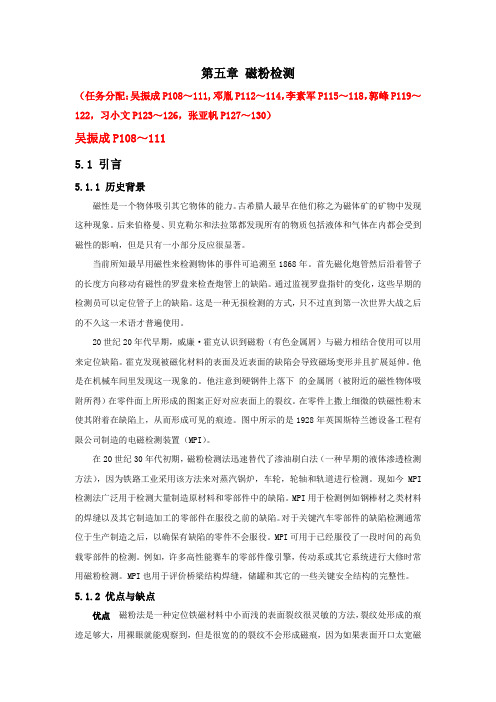
第五章磁粉检测(任务分配:吴振成P108~111,邓胤P112~114,李素军P115~118,郭峰P119~122,习小文P123~126,张亚帆P127~130)吴振成P108~1115.1 引言5.1.1 历史背景磁性是一个物体吸引其它物体的能力。
古希腊人最早在他们称之为磁体矿的矿物中发现这种现象。
后来伯格曼、贝克勒尔和法拉第都发现所有的物质包括液体和气体在内都会受到磁性的影响,但是只有一小部分反应很显著。
当前所知最早用磁性来检测物体的事件可追溯至1868年。
首先磁化炮管然后沿着管子的长度方向移动有磁性的罗盘来检查炮管上的缺陷。
通过监视罗盘指针的变化,这些早期的检测员可以定位管子上的缺陷。
这是一种无损检测的方式,只不过直到第一次世界大战之后的不久这一术语才普遍使用。
20世纪20年代早期,威廉·霍克认识到磁粉(有色金属屑)与磁力相结合使用可以用来定位缺陷。
霍克发现被磁化材料的表面及近表面的缺陷会导致磁场变形并且扩展延伸。
他是在机械车间里发现这一现象的。
他注意到硬钢件上落下的金属屑(被附近的磁性物体吸附所得)在零件面上所形成的图案正好对应表面上的裂纹。
在零件上撒上细微的铁磁性粉末使其附着在缺陷上,从而形成可见的痕迹。
图中所示的是1928年英国斯特兰德设备工程有限公司制造的电磁检测装置(MPI)。
在20世纪30年代初期,磁粉检测法迅速替代了渗油刷白法(一种早期的液体渗透检测方法),因为铁路工业采用该方法来对蒸汽锅炉,车轮,轮轴和轨道进行检测。
现如今MPI 检测法广泛用于检测大量制造原材料和零部件中的缺陷。
MPI用于检测例如钢棒材之类材料的焊缝以及其它制造加工的零部件在服役之前的缺陷。
对于关键汽车零部件的缺陷检测通常位于生产制造之后,以确保有缺陷的零件不会服役。
MPI可用于已经服役了一段时间的高负载零部件的检测。
例如,许多高性能赛车的零部件像引擎,传动系或其它系统进行大修时常用磁粉检测。
物理专业英语
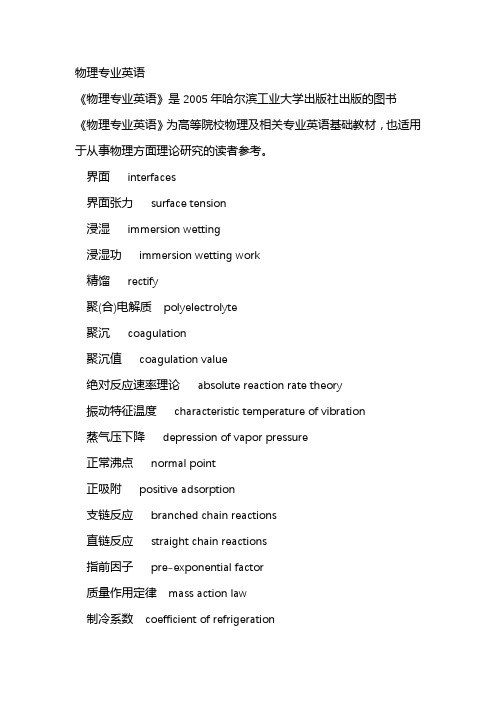
物理专业英语《物理专业英语》是2005年哈尔滨工业大学出版社出版的图书《物理专业英语》为高等院校物理及相关专业英语基础教材,也适用于从事物理方面理论研究的读者参考。
界面interfaces界面张力surface tension浸湿immersion wetting浸湿功immersion wetting work精馏rectify聚(合)电解质polyelectrolyte聚沉coagulation聚沉值coagulation value绝对反应速率理论absolute reaction rate theory振动特征温度characteristic temperature of vibration蒸气压下降depression of vapor pressure正常沸点normal point正吸附positive adsorption支链反应branched chain reactions直链反应straight chain reactions指前因子pre-exponential factor质量作用定律mass action law制冷系数coefficient of refrigeration中和热heat of neutralization阿伏加德罗常数Avogadro'number阿伏加德罗定律Avogadro law阿累尼乌斯电离理论Arrhenius ionization theory阿累尼乌斯方程Arrhenius equation阿累尼乌斯活化能Arrhenius activation energy阿马格定律Amagat law艾林方程Erying equation爱因斯坦光化当量定律Einstein's law of photochemical equivalence爱因斯坦-斯托克斯方程Einstein-Stokes equation安托万常数Antoine constant安托万方程Antoine equation盎萨格电导理论Onsager's theory of conductance半电池half cell半衰期half time period饱和液体saturated liquids饱和蒸气saturated vapor饱和吸附量saturated extent of adsorption饱和蒸气压saturated vapor pressure爆炸界限explosion limits比表面功specific surface work比表面吉布斯函数specific surface Gibbs function比浓粘度reduced viscosity标准电动势standard electromotive force标准电极电势standard electrode potential标准摩尔反应焓standard molar reaction enthalpy标准摩尔反应吉布斯函数standard Gibbs function of molar reaction标准摩尔反应熵standard molar reaction entropy标准摩尔焓函数standard molar enthalpy function标准摩尔吉布斯自由能函数standard molar Gibbs free energy function标准摩尔燃烧焓standard molar combustion enthalpy标准摩尔熵standard molar entropy标准摩尔生成焓standard molar formation enthalpy标准摩尔生成吉布斯函数standard molar formation Gibbs function标准平衡常数standard equilibrium constant标准氢电极standard hydrogen electrode标准态standard state标准熵standard entropy标准压力standard pressure标准状况standard condition表观活化能apparent activation energy表观摩尔质量apparent molecular weight表观迁移数apparent transference number 表面surfaces表面过程控制surface process control表面活性剂surfactants表面吸附量surface excess表面张力surface tension表面质量作用定律surface mass action law。
Symmetries in QFT
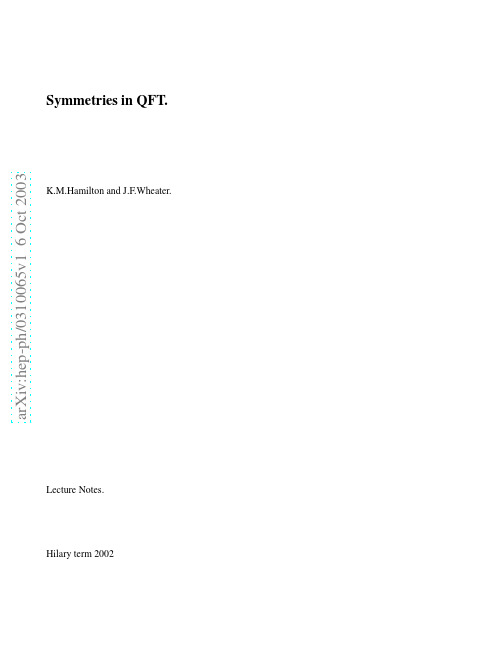
Dφ φ (x1 ) ...φ (xn ) exp i
(−1) G (x1 , ..., x2 )
n 1 (−1) Z n 1 (−1) Z n
Dφ′ φ′ (x1 ) ...φ′ (xn ) exp i dD x L (φ′ ) Dφ φ (x1 ) ...φ (xn ) exp i dD x L (φ)and QED. 4.1 One Loop Correction to the Photon Propagator. . . . . . . . . . . . . . . . . . . . . . . . . . . . . . 4.2 4.3 Resummation of loops. . . . . . . . . . . . . . . . . . . . . . . . . . . . . . . . . . . . . . . . . . . The Electron Self Energy and the Vertex Function. . . . . . . . . . . . . . . . . . . . . . . . . . . .
5
Anomalies. 5.1 5.2 5.3 Chiral Symmetry . . . . . . . . . . . . . . . . . . . . . . . . . . . . . . . . . . . . . . . . . . . . . . The ABJ Anomaly. . . . . . . . . . . . . . . . . . . . . . . . . . . . . . . . . . . . . . . . . . . . . Fujikawa’s Method for determining the Chiral Anomaly. . . . . . . . . . . . . . . . . . . . . . . . .
物理专业英语课件
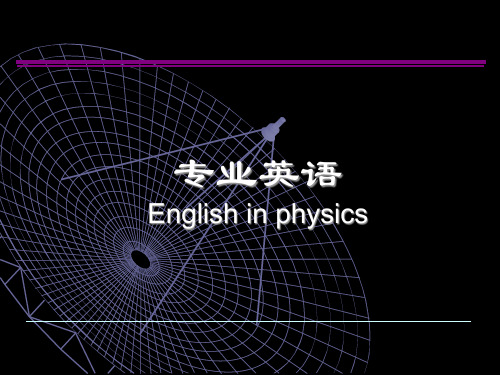
FRAME OF REFERENCE
The fact that if we choose different body as the reference to describe the same motion of a given object, the indications will be different, is called the relativity of the description and measurement of the motion, The particular body that serves as a reference chosen by the observer is defined as the frame of reference. It is usually pictured by means of a coordinate system, consisting three mutually perpendicular axes -X, -Y and Z-axes, and relative to it the position, velocity, acceleration and orbit of the moving object can be quantitatively specified. Particle is an ideal model used to simplify an object and to describe its motion. We can represent an object as a particle if every part of it moves in exactly the same way so that we can regard it as a mass point with no size and no shape. Translational motion -- the change of the position of the particle as a function of time will give a complete description of the motion for the given object.
(完整版)《物理专业英语》.doc
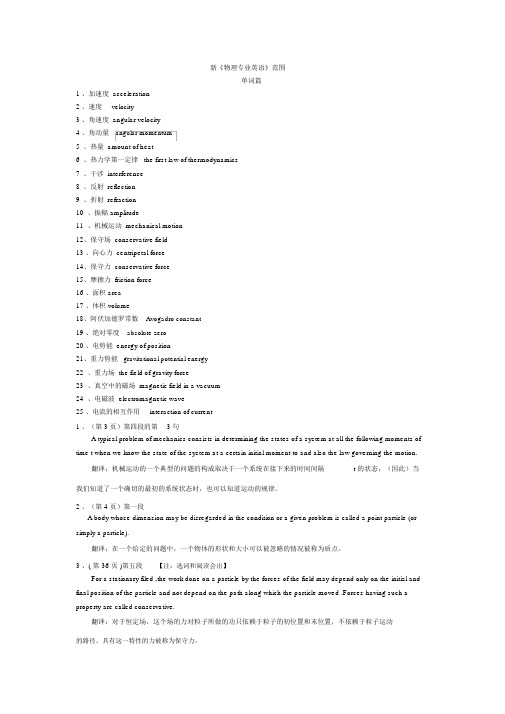
新《物理专业英语》范围单词篇1 、加速度 acceleration2 、速度velocity3 、角速度 angular velocity4 、角动量angular momentum5、热量 amount of heat6、热力学第一定律 the first law of thermodynamics7、干涉 interference8、反射 reflection9、折射 refraction10、振幅 amplitude11、机械运动 mechanical motion12、保守场 conservative field13 、向心力 centripetal force14、保守力 conservative force15、摩擦力 friction force16 、面积 area17 、体积 volume18、阿伏加德罗常数Avogadro constant19 、绝对零度absolute zero20 、电势能 energy of position21、重力势能gravitational potential energy22、重力场 the field of gravity force23、真空中的磁场 magnetic field in a vacuum24、电磁波 electromagnetic wave25 、电流的相互作用interaction of current1 、(第 3 页)第四段的第 3 句A typical problem of mechanics consists in determining the states of a system at all the following moments of time t when we know the state of the system at a certain initial moment to and also the law governing the motion.翻译:机械运动的一个典型的问题的构成取决于一个系统在接下来的时间间隔t 的状态,(因此)当我们知道了一个确切的最初的系统状态时,也可以知道运动的规律。
物理学专业英语A1

物理学专业英 语词汇:提高 学生专业英语
水平
添加 标题
添加 标题
添加 标题
添加 标题
课程目标:培养学 生掌握物理学专业 英语的基本知识和 技能提高英语阅读、 写作和表达能力。
课程内容:涵盖物 理学各个领域的基 本概念、原理和方 法包括力学、热学、 电磁学、光学、原 子物理和量子力学 等方面的英文阅读
光学:研究光的 性质、传播和应 用的科学包括折 射、反射等。
电学:研究电场、 电流和电磁现象 的科学包括欧姆 定律、法拉第电 磁感应等。
热学:研究热量、 温度和物态变化 的科学包括热力 学第一定律、热 力学第二定律等。
牛顿第二定律: F=m
动量守恒定律: p1+p2=p1'+p2'
机械能守恒定律 : E1+E2=E1'+E2'
论文写作是物理学专业英语1课程的重要实践应用之一 学生通过论文写作能够提高英语表达能力和学术写作技巧 论文写作有助于加深对物理学专业知识的理解和掌握 在论文写作过程中学生需要注意学术规范和引用格式的要求
物理学专业英语1课程实践应用:培养学生运用英语进行学术交流的能力包括阅读、写作、听力 和口语等方面的训练。
究中的应用
物理学专业英 语1课程实践应 用:在技术交
流中的应用
物理学专业英 语1课程实践应 用:在国际会
议中的应用
物理学专业英 语1课程实践应 用:在教育领
域中的应用
物理学专业英语1课程的学习目 标是什么?
如何提高物理学专业英语1的阅 读理解能力?
物理学专业英语1课程中常见的 词汇有哪些?
如何有效地记忆和理解物理学 专业英语1中的专业术语?
和写作训练。
物理学类专业英语_基础课程
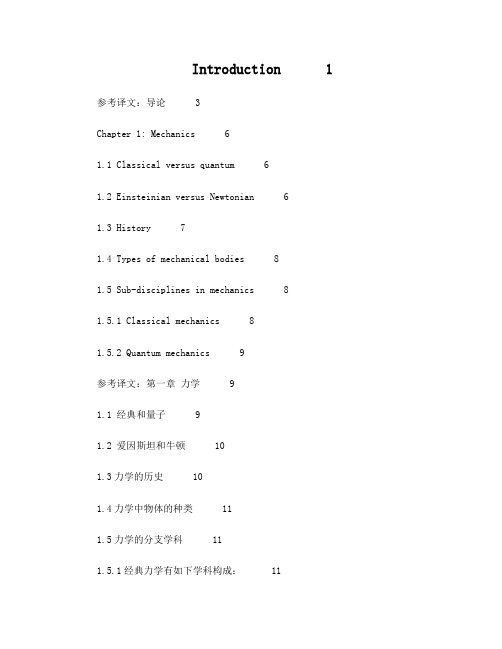
Introduction 1 参考译文:导论 3Chapter 1: Mechanics 61.1 Classical versus quantum 61.2 Einsteinian versus Newtonian 61.3 History 71.4 Types of mechanical bodies 81.5 Sub-disciplines in mechanics 81.5.1 Classical mechanics 81.5.2 Quantum mechanics 9参考译文:第一章力学 91.1 经典和量子 91.2 爱因斯坦和牛顿 101.3力学的历史 101.4力学中物体的种类 111.5力学的分支学科 111.5.1经典力学有如下学科构成: 111.5.2量子力学 12Chapter 2: Heat 132.1 Overview 132.2 Notation 142.3 Definitions 152.4 Thermodynamics 152.4.1 Internal energy 152.4.2 Heat capacity 162.4.3 Phase Changes 172.5 Heat transfer mechanisms 17 2.6 Heat dissipation 19参考译文:第二章热学 202.1 综述 202.2 符号 212.3 定义 212.4 热力学 212.4.1 内能 212.4.2 热容量 222.4.3 相变 232.5 热传递的机制 232.6 散热 24Chapter 3: Electromagnetism 25 3.1 History 253.2 Overview 273.3 Classical electrodynamics 27 3.4 The photoelectric effect 28 3.5 Maxwell's equations 293.6 Special relativity 30参考译文:第三章电磁学 343.1 发展历史 353.2 总论 363.3 经典电动力学 363.4 光电效应 373.5 麦克斯韦方程组 373.6 狭义相对论 37Chapter 4 Optics 414.1 History 414.2 Classical optics 434.2.1 Geometrical optics 44 4.2.2 Physical optics 46 4.3 Modern optics 514.3.1 Lasers 524.3.2 Nonlinear optics 59 参考译文:第四章光学 59 4.1 光学的历史 604.2 经典光学 614.2.1 几何光学 614.2.2 物理光学 634.3 现代光学 664.3.1激光 664.3.2 非线性光学 71Chapter 5 Atomic physics 725.1 Isolated atoms 725.2 Electronic configuration 725.3 History and developments 735.3.1 Introduction to Atomic Physics 74 5.3.2 Atomic Structure 745.3.3 Bohr atom structure model 755.3.4 Atomic Isotopes 765.3.5 Einstein's Equation 765.3.6 Radioactive Decay 77参考译文:第五章原子物理 795.1 孤立原子 795.2 电子图像 795.3 原子物理的历史和发展过程 805.3.1 原子物理引论 805.3.2 原子结构 805.3.3波尔的原子结构模型 815.3.4 原子的同位素 815.3.5 爱因斯坦方程 825.3.6 放射性衰变 82Chapter 6: Quantum mechanics 846.1 Overview 856.2 Quantum mechanics and classical physics 86 6.3 Theory 866.4 Mathematical formulation 89。
物理学专业英语

华中师范大学物理学院物理学专业英语仅供内部学习参考!2014一、课程的任务和教学目的通过学习《物理学专业英语》,学生将掌握物理学领域使用频率较高的专业词汇和表达方法,进而具备基本的阅读理解物理学专业文献的能力。
通过分析《物理学专业英语》课程教材中的范文,学生还将从英语角度理解物理学中个学科的研究内容和主要思想,提高学生的专业英语能力和了解物理学研究前沿的能力。
培养专业英语阅读能力,了解科技英语的特点,提高专业外语的阅读质量和阅读速度;掌握一定量的本专业英文词汇,基本达到能够独立完成一般性本专业外文资料的阅读;达到一定的笔译水平。
要求译文通顺、准确和专业化。
要求译文通顺、准确和专业化。
二、课程内容课程内容包括以下章节:物理学、经典力学、热力学、电磁学、光学、原子物理、统计力学、量子力学和狭义相对论三、基本要求1.充分利用课内时间保证充足的阅读量(约1200~1500词/学时),要求正确理解原文。
2.泛读适量课外相关英文读物,要求基本理解原文主要内容。
3.掌握基本专业词汇(不少于200词)。
4.应具有流利阅读、翻译及赏析专业英语文献,并能简单地进行写作的能力。
四、参考书目录1 Physics 物理学 (1)Introduction to physics (1)Classical and modern physics (2)Research fields (4)V ocabulary (7)2 Classical mechanics 经典力学 (10)Introduction (10)Description of classical mechanics (10)Momentum and collisions (14)Angular momentum (15)V ocabulary (16)3 Thermodynamics 热力学 (18)Introduction (18)Laws of thermodynamics (21)System models (22)Thermodynamic processes (27)Scope of thermodynamics (29)V ocabulary (30)4 Electromagnetism 电磁学 (33)Introduction (33)Electrostatics (33)Magnetostatics (35)Electromagnetic induction (40)V ocabulary (43)5 Optics 光学 (45)Introduction (45)Geometrical optics (45)Physical optics (47)Polarization (50)V ocabulary (51)6 Atomic physics 原子物理 (52)Introduction (52)Electronic configuration (52)Excitation and ionization (56)V ocabulary (59)7 Statistical mechanics 统计力学 (60)Overview (60)Fundamentals (60)Statistical ensembles (63)V ocabulary (65)8 Quantum mechanics 量子力学 (67)Introduction (67)Mathematical formulations (68)Quantization (71)Wave-particle duality (72)Quantum entanglement (75)V ocabulary (77)9 Special relativity 狭义相对论 (79)Introduction (79)Relativity of simultaneity (80)Lorentz transformations (80)Time dilation and length contraction (81)Mass-energy equivalence (82)Relativistic energy-momentum relation (86)V ocabulary (89)正文标记说明:蓝色Arial字体(例如energy):已知的专业词汇蓝色Arial字体加下划线(例如electromagnetism):新学的专业词汇黑色Times New Roman字体加下划线(例如postulate):新学的普通词汇1 Physics 物理学1 Physics 物理学Introduction to physicsPhysics is a part of natural philosophy and a natural science that involves the study of matter and its motion through space and time, along with related concepts such as energy and force. More broadly, it is the general analysis of nature, conducted in order to understand how the universe behaves.Physics is one of the oldest academic disciplines, perhaps the oldest through its inclusion of astronomy. Over the last two millennia, physics was a part of natural philosophy along with chemistry, certain branches of mathematics, and biology, but during the Scientific Revolution in the 17th century, the natural sciences emerged as unique research programs in their own right. Physics intersects with many interdisciplinary areas of research, such as biophysics and quantum chemistry,and the boundaries of physics are not rigidly defined. New ideas in physics often explain the fundamental mechanisms of other sciences, while opening new avenues of research in areas such as mathematics and philosophy.Physics also makes significant contributions through advances in new technologies that arise from theoretical breakthroughs. For example, advances in the understanding of electromagnetism or nuclear physics led directly to the development of new products which have dramatically transformed modern-day society, such as television, computers, domestic appliances, and nuclear weapons; advances in thermodynamics led to the development of industrialization; and advances in mechanics inspired the development of calculus.Core theoriesThough physics deals with a wide variety of systems, certain theories are used by all physicists. Each of these theories were experimentally tested numerous times and found correct as an approximation of nature (within a certain domain of validity).For instance, the theory of classical mechanics accurately describes the motion of objects, provided they are much larger than atoms and moving at much less than the speed of light. These theories continue to be areas of active research, and a remarkable aspect of classical mechanics known as chaos was discovered in the 20th century, three centuries after the original formulation of classical mechanics by Isaac Newton (1642–1727) 【艾萨克·牛顿】.University PhysicsThese central theories are important tools for research into more specialized topics, and any physicist, regardless of his or her specialization, is expected to be literate in them. These include classical mechanics, quantum mechanics, thermodynamics and statistical mechanics, electromagnetism, and special relativity.Classical and modern physicsClassical mechanicsClassical physics includes the traditional branches and topics that were recognized and well-developed before the beginning of the 20th century—classical mechanics, acoustics, optics, thermodynamics, and electromagnetism.Classical mechanics is concerned with bodies acted on by forces and bodies in motion and may be divided into statics (study of the forces on a body or bodies at rest), kinematics (study of motion without regard to its causes), and dynamics (study of motion and the forces that affect it); mechanics may also be divided into solid mechanics and fluid mechanics (known together as continuum mechanics), the latter including such branches as hydrostatics, hydrodynamics, aerodynamics, and pneumatics.Acoustics is the study of how sound is produced, controlled, transmitted and received. Important modern branches of acoustics include ultrasonics, the study of sound waves of very high frequency beyond the range of human hearing; bioacoustics the physics of animal calls and hearing, and electroacoustics, the manipulation of audible sound waves using electronics.Optics, the study of light, is concerned not only with visible light but also with infrared and ultraviolet radiation, which exhibit all of the phenomena of visible light except visibility, e.g., reflection, refraction, interference, diffraction, dispersion, and polarization of light.Heat is a form of energy, the internal energy possessed by the particles of which a substance is composed; thermodynamics deals with the relationships between heat and other forms of energy.Electricity and magnetism have been studied as a single branch of physics since the intimate connection between them was discovered in the early 19th century; an electric current gives rise to a magnetic field and a changing magnetic field induces an electric current. Electrostatics deals with electric charges at rest, electrodynamics with moving charges, and magnetostatics with magnetic poles at rest.Modern PhysicsClassical physics is generally concerned with matter and energy on the normal scale of1 Physics 物理学observation, while much of modern physics is concerned with the behavior of matter and energy under extreme conditions or on the very large or very small scale.For example, atomic and nuclear physics studies matter on the smallest scale at which chemical elements can be identified.The physics of elementary particles is on an even smaller scale, as it is concerned with the most basic units of matter; this branch of physics is also known as high-energy physics because of the extremely high energies necessary to produce many types of particles in large particle accelerators. On this scale, ordinary, commonsense notions of space, time, matter, and energy are no longer valid.The two chief theories of modern physics present a different picture of the concepts of space, time, and matter from that presented by classical physics.Quantum theory is concerned with the discrete, rather than continuous, nature of many phenomena at the atomic and subatomic level, and with the complementary aspects of particles and waves in the description of such phenomena.The theory of relativity is concerned with the description of phenomena that take place in a frame of reference that is in motion with respect to an observer; the special theory of relativity is concerned with relative uniform motion in a straight line and the general theory of relativity with accelerated motion and its connection with gravitation.Both quantum theory and the theory of relativity find applications in all areas of modern physics.Difference between classical and modern physicsWhile physics aims to discover universal laws, its theories lie in explicit domains of applicability. Loosely speaking, the laws of classical physics accurately describe systems whose important length scales are greater than the atomic scale and whose motions are much slower than the speed of light. Outside of this domain, observations do not match their predictions.Albert Einstein【阿尔伯特·爱因斯坦】contributed the framework of special relativity, which replaced notions of absolute time and space with space-time and allowed an accurate description of systems whose components have speeds approaching the speed of light.Max Planck【普朗克】, Erwin Schrödinger【薛定谔】, and others introduced quantum mechanics, a probabilistic notion of particles and interactions that allowed an accurate description of atomic and subatomic scales.Later, quantum field theory unified quantum mechanics and special relativity.General relativity allowed for a dynamical, curved space-time, with which highly massiveUniversity Physicssystems and the large-scale structure of the universe can be well-described. General relativity has not yet been unified with the other fundamental descriptions; several candidate theories of quantum gravity are being developed.Research fieldsContemporary research in physics can be broadly divided into condensed matter physics; atomic, molecular, and optical physics; particle physics; astrophysics; geophysics and biophysics. Some physics departments also support research in Physics education.Since the 20th century, the individual fields of physics have become increasingly specialized, and today most physicists work in a single field for their entire careers. "Universalists" such as Albert Einstein (1879–1955) and Lev Landau (1908–1968)【列夫·朗道】, who worked in multiple fields of physics, are now very rare.Condensed matter physicsCondensed matter physics is the field of physics that deals with the macroscopic physical properties of matter. In particular, it is concerned with the "condensed" phases that appear whenever the number of particles in a system is extremely large and the interactions between them are strong.The most familiar examples of condensed phases are solids and liquids, which arise from the bonding by way of the electromagnetic force between atoms. More exotic condensed phases include the super-fluid and the Bose–Einstein condensate found in certain atomic systems at very low temperature, the superconducting phase exhibited by conduction electrons in certain materials,and the ferromagnetic and antiferromagnetic phases of spins on atomic lattices.Condensed matter physics is by far the largest field of contemporary physics.Historically, condensed matter physics grew out of solid-state physics, which is now considered one of its main subfields. The term condensed matter physics was apparently coined by Philip Anderson when he renamed his research group—previously solid-state theory—in 1967. In 1978, the Division of Solid State Physics of the American Physical Society was renamed as the Division of Condensed Matter Physics.Condensed matter physics has a large overlap with chemistry, materials science, nanotechnology and engineering.Atomic, molecular and optical physicsAtomic, molecular, and optical physics (AMO) is the study of matter–matter and light–matter interactions on the scale of single atoms and molecules.1 Physics 物理学The three areas are grouped together because of their interrelationships, the similarity of methods used, and the commonality of the energy scales that are relevant. All three areas include both classical, semi-classical and quantum treatments; they can treat their subject from a microscopic view (in contrast to a macroscopic view).Atomic physics studies the electron shells of atoms. Current research focuses on activities in quantum control, cooling and trapping of atoms and ions, low-temperature collision dynamics and the effects of electron correlation on structure and dynamics. Atomic physics is influenced by the nucleus (see, e.g., hyperfine splitting), but intra-nuclear phenomena such as fission and fusion are considered part of high-energy physics.Molecular physics focuses on multi-atomic structures and their internal and external interactions with matter and light.Optical physics is distinct from optics in that it tends to focus not on the control of classical light fields by macroscopic objects, but on the fundamental properties of optical fields and their interactions with matter in the microscopic realm.High-energy physics (particle physics) and nuclear physicsParticle physics is the study of the elementary constituents of matter and energy, and the interactions between them.In addition, particle physicists design and develop the high energy accelerators,detectors, and computer programs necessary for this research. The field is also called "high-energy physics" because many elementary particles do not occur naturally, but are created only during high-energy collisions of other particles.Currently, the interactions of elementary particles and fields are described by the Standard Model.●The model accounts for the 12 known particles of matter (quarks and leptons) thatinteract via the strong, weak, and electromagnetic fundamental forces.●Dynamics are described in terms of matter particles exchanging gauge bosons (gluons,W and Z bosons, and photons, respectively).●The Standard Model also predicts a particle known as the Higgs boson. In July 2012CERN, the European laboratory for particle physics, announced the detection of a particle consistent with the Higgs boson.Nuclear Physics is the field of physics that studies the constituents and interactions of atomic nuclei. The most commonly known applications of nuclear physics are nuclear power generation and nuclear weapons technology, but the research has provided application in many fields, including those in nuclear medicine and magnetic resonance imaging, ion implantation in materials engineering, and radiocarbon dating in geology and archaeology.University PhysicsAstrophysics and Physical CosmologyAstrophysics and astronomy are the application of the theories and methods of physics to the study of stellar structure, stellar evolution, the origin of the solar system, and related problems of cosmology. Because astrophysics is a broad subject, astrophysicists typically apply many disciplines of physics, including mechanics, electromagnetism, statistical mechanics, thermodynamics, quantum mechanics, relativity, nuclear and particle physics, and atomic and molecular physics.The discovery by Karl Jansky in 1931 that radio signals were emitted by celestial bodies initiated the science of radio astronomy. Most recently, the frontiers of astronomy have been expanded by space exploration. Perturbations and interference from the earth's atmosphere make space-based observations necessary for infrared, ultraviolet, gamma-ray, and X-ray astronomy.Physical cosmology is the study of the formation and evolution of the universe on its largest scales. Albert Einstein's theory of relativity plays a central role in all modern cosmological theories. In the early 20th century, Hubble's discovery that the universe was expanding, as shown by the Hubble diagram, prompted rival explanations known as the steady state universe and the Big Bang.The Big Bang was confirmed by the success of Big Bang nucleo-synthesis and the discovery of the cosmic microwave background in 1964. The Big Bang model rests on two theoretical pillars: Albert Einstein's general relativity and the cosmological principle (On a sufficiently large scale, the properties of the Universe are the same for all observers). Cosmologists have recently established the ΛCDM model (the standard model of Big Bang cosmology) of the evolution of the universe, which includes cosmic inflation, dark energy and dark matter.Current research frontiersIn condensed matter physics, an important unsolved theoretical problem is that of high-temperature superconductivity. Many condensed matter experiments are aiming to fabricate workable spintronics and quantum computers.In particle physics, the first pieces of experimental evidence for physics beyond the Standard Model have begun to appear. Foremost among these are indications that neutrinos have non-zero mass. These experimental results appear to have solved the long-standing solar neutrino problem, and the physics of massive neutrinos remains an area of active theoretical and experimental research. Particle accelerators have begun probing energy scales in the TeV range, in which experimentalists are hoping to find evidence for the super-symmetric particles, after discovery of the Higgs boson.Theoretical attempts to unify quantum mechanics and general relativity into a single theory1 Physics 物理学of quantum gravity, a program ongoing for over half a century, have not yet been decisively resolved. The current leading candidates are M-theory, superstring theory and loop quantum gravity.Many astronomical and cosmological phenomena have yet to be satisfactorily explained, including the existence of ultra-high energy cosmic rays, the baryon asymmetry, the acceleration of the universe and the anomalous rotation rates of galaxies.Although much progress has been made in high-energy, quantum, and astronomical physics, many everyday phenomena involving complexity, chaos, or turbulence are still poorly understood. Complex problems that seem like they could be solved by a clever application of dynamics and mechanics remain unsolved; examples include the formation of sand-piles, nodes in trickling water, the shape of water droplets, mechanisms of surface tension catastrophes, and self-sorting in shaken heterogeneous collections.These complex phenomena have received growing attention since the 1970s for several reasons, including the availability of modern mathematical methods and computers, which enabled complex systems to be modeled in new ways. Complex physics has become part of increasingly interdisciplinary research, as exemplified by the study of turbulence in aerodynamics and the observation of pattern formation in biological systems.Vocabulary★natural science 自然科学academic disciplines 学科astronomy 天文学in their own right 凭他们本身的实力intersects相交,交叉interdisciplinary交叉学科的,跨学科的★quantum 量子的theoretical breakthroughs 理论突破★electromagnetism 电磁学dramatically显著地★thermodynamics热力学★calculus微积分validity 有效性, 正确性★classical mechanics 经典力学chaos 混沌literate 学者★quantum mechanics量子力学★thermodynamics and statistical mechanics热力学与统计物理★special relativity狭义相对论is concerned with 关注,讨论,考虑acoustics 声学★optics 光学statics静力学at rest 静息kinematics运动学★dynamics动力学ultrasonics超声学University Physicsmanipulation 操作,处理,使用infrared红外ultraviolet紫外radiation辐射reflection 反射refraction 折射★interference 干涉★diffraction 衍射dispersion散射★polarization 极化,偏振internal energy 内能Electricity电性Magnetism 磁性intimate 亲密的induces 诱导,感应scale尺度★elementary particles基本粒子★high-energy physics 高能物理particle accelerators 粒子加速器valid 有效的,正当的★discrete离散的continuous 连续的complementary 互补的★frame of reference 参照系★the special theory of relativity 狭义相对论★general theory of relativity 广义相对论gravitation 重力,万有引力explicit 详细的,清楚的★candidate 候选的,候选人★quantum field theory 量子场论★condensed matter physics凝聚态物理astrophysics天体物理geophysics地球物理Universalist博学多才者★Macroscopic宏观Exotic奇异的★Superconducting 超导Ferromagnetic铁磁质Antiferromagnetic 反铁磁质★Spin自旋lattice 晶格,点阵,网格★Society社会,学会★microscopic微观的hyperfine splitting超精细分裂fission分裂,裂变fusion熔合,聚变constituents成分,组分accelerators加速器detectors 检测器★quarks夸克lepton 轻子gauge bosons规范玻色子gluons胶子★Higgs boson希格斯玻色子CERN欧洲核子研究中心★Magnetic Resonance Imaging磁共振成像,核磁共振ion implantation 离子注入radiocarbon dating放射性碳年代测定法geology地质学archaeology考古学stellar 恒星cosmology宇宙论celestial bodies 天体Hubble diagram 哈勃图rval竞争的★Big Bang大爆炸nucleo-synthesis核聚合,核合成pillar支柱cosmological principle宇宙学原理1 Physics 物理学ΛCDM modelΛ-冷暗物质模型cosmic inflation宇宙膨胀fabricate制造,建造spintronics自旋电子元件,自旋电子学★neutrinos 中微子superstring 超弦baryon重子turbulence湍流,扰动,骚动catastrophes突变,灾变,灾难heterogeneous collections异质性集合pattern formation模式形成University Physics2 Classical mechanics 经典力学IntroductionIn physics, classical mechanics is one of the two major sub-fields of mechanics, which is concerned with the set of physical laws describing the motion of bodies under the action of a system of forces. The study of the motion of bodies is an ancient one, making classical mechanics one of the oldest and largest subjects in science, engineering and technology.Classical mechanics describes the motion of macroscopic objects, from projectiles to parts of machinery, as well as astronomical objects, such as spacecraft, planets, stars, and galaxies. Besides this, many specializations within the subject deal with gases, liquids, solids, and other specific sub-topics.Classical mechanics provides extremely accurate results as long as the domain of study is restricted to large objects and the speeds involved do not approach the speed of light. When the objects being dealt with become sufficiently small, it becomes necessary to introduce the other major sub-field of mechanics, quantum mechanics, which reconciles the macroscopic laws of physics with the atomic nature of matter and handles the wave–particle duality of atoms and molecules. In the case of high velocity objects approaching the speed of light, classical mechanics is enhanced by special relativity. General relativity unifies special relativity with Newton's law of universal gravitation, allowing physicists to handle gravitation at a deeper level.The initial stage in the development of classical mechanics is often referred to as Newtonian mechanics, and is associated with the physical concepts employed by and the mathematical methods invented by Newton himself, in parallel with Leibniz【莱布尼兹】, and others.Later, more abstract and general methods were developed, leading to reformulations of classical mechanics known as Lagrangian mechanics and Hamiltonian mechanics. These advances were largely made in the 18th and 19th centuries, and they extend substantially beyond Newton's work, particularly through their use of analytical mechanics. Ultimately, the mathematics developed for these were central to the creation of quantum mechanics.Description of classical mechanicsThe following introduces the basic concepts of classical mechanics. For simplicity, it often2 Classical mechanics 经典力学models real-world objects as point particles, objects with negligible size. The motion of a point particle is characterized by a small number of parameters: its position, mass, and the forces applied to it.In reality, the kind of objects that classical mechanics can describe always have a non-zero size. (The physics of very small particles, such as the electron, is more accurately described by quantum mechanics). Objects with non-zero size have more complicated behavior than hypothetical point particles, because of the additional degrees of freedom—for example, a baseball can spin while it is moving. However, the results for point particles can be used to study such objects by treating them as composite objects, made up of a large number of interacting point particles. The center of mass of a composite object behaves like a point particle.Classical mechanics uses common-sense notions of how matter and forces exist and interact. It assumes that matter and energy have definite, knowable attributes such as where an object is in space and its speed. It also assumes that objects may be directly influenced only by their immediate surroundings, known as the principle of locality.In quantum mechanics objects may have unknowable position or velocity, or instantaneously interact with other objects at a distance.Position and its derivativesThe position of a point particle is defined with respect to an arbitrary fixed reference point, O, in space, usually accompanied by a coordinate system, with the reference point located at the origin of the coordinate system. It is defined as the vector r from O to the particle.In general, the point particle need not be stationary relative to O, so r is a function of t, the time elapsed since an arbitrary initial time.In pre-Einstein relativity (known as Galilean relativity), time is considered an absolute, i.e., the time interval between any given pair of events is the same for all observers. In addition to relying on absolute time, classical mechanics assumes Euclidean geometry for the structure of space.Velocity and speedThe velocity, or the rate of change of position with time, is defined as the derivative of the position with respect to time. In classical mechanics, velocities are directly additive and subtractive as vector quantities; they must be dealt with using vector analysis.When both objects are moving in the same direction, the difference can be given in terms of speed only by ignoring direction.University PhysicsAccelerationThe acceleration , or rate of change of velocity, is the derivative of the velocity with respect to time (the second derivative of the position with respect to time).Acceleration can arise from a change with time of the magnitude of the velocity or of the direction of the velocity or both . If only the magnitude v of the velocity decreases, this is sometimes referred to as deceleration , but generally any change in the velocity with time, including deceleration, is simply referred to as acceleration.Inertial frames of referenceWhile the position and velocity and acceleration of a particle can be referred to any observer in any state of motion, classical mechanics assumes the existence of a special family of reference frames in terms of which the mechanical laws of nature take a comparatively simple form. These special reference frames are called inertial frames .An inertial frame is such that when an object without any force interactions (an idealized situation) is viewed from it, it appears either to be at rest or in a state of uniform motion in a straight line. This is the fundamental definition of an inertial frame. They are characterized by the requirement that all forces entering the observer's physical laws originate in identifiable sources (charges, gravitational bodies, and so forth).A non-inertial reference frame is one accelerating with respect to an inertial one, and in such a non-inertial frame a particle is subject to acceleration by fictitious forces that enter the equations of motion solely as a result of its accelerated motion, and do not originate in identifiable sources. These fictitious forces are in addition to the real forces recognized in an inertial frame.A key concept of inertial frames is the method for identifying them. For practical purposes, reference frames that are un-accelerated with respect to the distant stars are regarded as good approximations to inertial frames.Forces; Newton's second lawNewton was the first to mathematically express the relationship between force and momentum . Some physicists interpret Newton's second law of motion as a definition of force and mass, while others consider it a fundamental postulate, a law of nature. Either interpretation has the same mathematical consequences, historically known as "Newton's Second Law":a m t v m t p F ===d )(d d dThe quantity m v is called the (canonical ) momentum . The net force on a particle is thus equal to rate of change of momentum of the particle with time.So long as the force acting on a particle is known, Newton's second law is sufficient to。
《物理化学》的中英文翻译
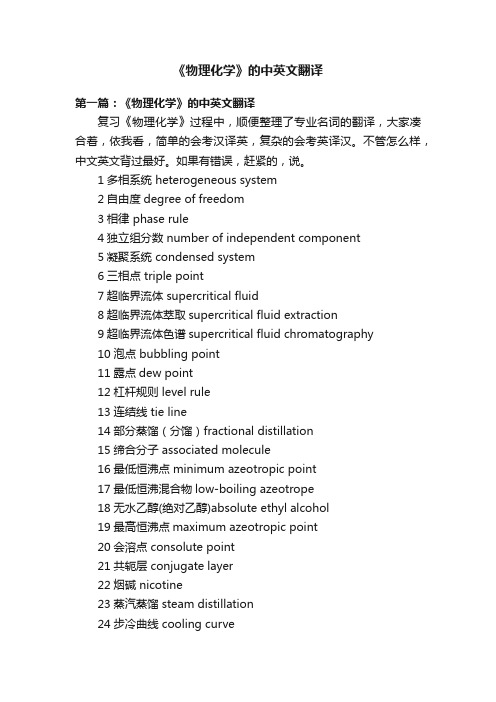
《物理化学》的中英文翻译第一篇:《物理化学》的中英文翻译复习《物理化学》过程中,顺便整理了专业名词的翻译,大家凑合着,依我看,简单的会考汉译英,复杂的会考英译汉。
不管怎么样,中文英文背过最好。
如果有错误,赶紧的,说。
1多相系统 heterogeneous system2自由度degree of freedom3相律 phase rule4独立组分数 number of independent component5凝聚系统 condensed system6三相点 triple point7超临界流体 supercritical fluid8超临界流体萃取supercritical fluid extraction9超临界流体色谱supercritical fluid chromatography10泡点 bubbling point11露点dew point12杠杆规则 level rule13连结线 tie line14部分蒸馏(分馏)fractional distillation15缔合分子 associated molecule16最低恒沸点 minimum azeotropic point17最低恒沸混合物low-boiling azeotrope18无水乙醇(绝对乙醇)absolute ethyl alcohol19最高恒沸点maximum azeotropic point20会溶点 consolute point21共轭层 conjugate layer22烟碱 nicotine23蒸汽蒸馏 steam distillation24步冷曲线 cooling curve25热分析法 thermal analysis26低共熔点 eutectic point27低共熔混合物eutectic mixture28异成分熔点 incongruent melting point29转熔温度 peritectic tempreture30固溶体 solid solution31退火 annealing32淬火 quenching33区域熔炼 zone melting34分凝系数 fractional coagulation coefficient35褶点 plait point36等温会溶点 isothermal consolute point37双节点溶解度曲线 binodal solubility cueve38一(二)级相变first(second)order phase transition39超流体 super fluid40顺磁体 paramagnetic substance41铁磁体 ferromagnetic substance第二篇:中英文翻译蓄电池 battery 充电 converter 转换器 charger开关电器Switch electric 按钮开关Button to switch 电源电器Power electric 插头插座 Plug sockets第三篇:中英文翻译Fundamentals This chapter describes the fundamentals of today’s wireless communications.First a detailed description of the radio channel and its modeling are presented, followed by the introduction of the principle of OFDM multi-carrier transmission.In addition, a general overview of the spread spectrum technique, especially DS-CDMA, is given and examples of potential applications for OFDM and DS-CDMA areanalyzed.This introduction is essential for a better understanding of the idea behind the combination of OFDM with the spread spectrum technique, which is briefly introduced in the last part of this chapter.1.1 Radio Channel Characteristics Understanding the characteristics of the communications medium is crucial for the appropriate selection of transmission system architecture, dimensioning of its components, and optimizing system parameters, especially since mobile radio channels are considered to be the most difficult channels, since they suffer from many imperfections like multipath fading, interference, Doppler shift, and shadowing.The choice of system components is totally different if, for instance, multipath propagation with long echoes dominates the radio propagation.Therefore, an accurate channel model describing the behavior of radio wave propagation in different environments such as mobile/fixed and indoor/outdoor is needed.This may allow one, through simulations, to estimate and validate the performance of a given transmission scheme in its several design phases.1.1.1 Understanding Radio Channels In mobile radio channels(see Figure 1-1), the transmitted signal suffers from different effects, which are characterized as follows: Multipath propagation occurs as a consequence of reflections, scattering, and diffraction of the transmitted electromagnetic wave at natural and man-made objects.Thus, at the receiver antenna, a multitude of waves arrives from many different directions with different delays, attenuations, and phases.The superposition of these waves results in amplitude and phase variations of the composite received signal.Doppler spread is caused by moving objects in the mobile radio channel.Changes in the phases and amplitudes of the arriving waves occur which lead to time-variant multipathpropagation.Even small movements on the order of the wavelength may result in a totally different wave superposition.The varying signal strength due to time-variant multipath propagation is referred to as fast fading.Shadowing is caused by obstruction of the transmitted waves by, e.g., hills, buildings, walls, and trees, which results in more or less strong attenuation of the signal pared to fast fading, longer distances have to be covered to significantly change the shadowing constellation.The varying signal strength due to shadowing is called slow fading and can be described by a log-normal distribution [36].Path loss indicates how the mean signal power decays with distance between transmitter and receiver.In free space, the mean signal power decreases with the square of the distance between base station(BS)and terminal station(TS).In a mobile radio channel, where often no line of sight(LOS)path exists, signal power decreases with a power higher than two and is typically in the order of three to five.Variations of the received power due to shadowing and path loss can be efficiently counteracted by power control.In the following, the mobile radio channel is described with respect to its fast fading characteristic.1.1.2 Channel Modeling The mobile radio channel can be characterized by the time-variant channel impulse response h(τ , t)or by the time-variant channel transfer function H(f, t), which is the Fourier transform of h(τ, t).The channel impulse response represents the response of the channel at time t due to an impulse applied at time t −τ.The mobile radio channel is assumed to be a wide-sense stationary random process, i.e., the channel has a fading statistic that remains constant over short periods of time or small spatial distances.In environments with multipath propagation, the channel impulseresponse is composed of a large number of scattered impulses received over Np different paths,Whereand ap, fD,p, ϕp, and τp are the amplitude, the Doppler frequency, the phase, and the propagation delay, respectively, associated with path p, p = 0,..., Np −1.The assigned channel transfer function isThe delays are measured relative to the first detectable path at the receiver.The Doppler Frequencydepends on the velocity v of the terminal station, the speed of light c, the carrier frequency fc, and the angle of incidence αp of a wave assigned to path p.A channel impulse response with corresponding channel transfer function is illustrated in Figure 1-2.The delay power density spectrum ρ(τ)that characterizes the frequency selectivity of the mobile radio channel gives the average power of the channel output as a function of the delay τ.The mean delay τ , the root mean square(RMS)de lay spread τRMS and the maximum delay τmax are characteristic parameters of the delay power density spectrum.The mean delay isWhereFigure 1-2 Time-variant channel impulse response and channel transfer function with frequency-selective fading is the power of path p.The RMS delay spread is defined as Similarly, the Doppler power density spectrum S(fD)can be defined that characterizes the time variance of the mobile radio channel and gives the average power of the channel output as a function of the Doppler frequency fD.The frequency dispersive properties of multipath channels are most commonly quantified by the maximum occurring Doppler frequency fDmax and the Doppler spread fDspread.The Doppler spread is the bandwidth of theDoppler power density spectrum and can take on values up to two times |fDmax|, i.e.,1.1.3Channel Fade Statistics The statistics of the fading process characterize the channel and are of importance for channel model parameter specifications.A simple and often used approach is obtained from the assumption that there is a large number of scatterers in the channel that contribute to the signal at the receiver side.The application of the central limit theorem leads to a complex-valued Gaussian process for the channel impulse response.In the absence of line of sight(LOS)or a dominant component, the process is zero-mean.The magnitude of the corresponding channel transfer functionis a random variable, for brevity denoted by a, with a Rayleigh distribution given byWhereis the average power.The phase is uniformly distributed in the interval [0, 2π].In the case that the multipath channel contains a LOS or dominant component in addition to the randomly moving scatterers, the channel impulse response can no longer be modeled as zero-mean.Under the assumption of a complex-valued Gaussian process for the channel impulse response, the magnitude a of the channel transfer function has a Rice distribution given byThe Rice factor KRice is determined by the ratio of the power of the dominant path to thepower of the scattered paths.I0 is the zero-order modified Bessel function of first kind.The phase is uniformly distributed in the interval [0, 2π].1.1.4Inter-Symbol(ISI)and Inter-Channel Interference(ICI)The delay spread can cause inter-symbol interference(ISI)when adjacent data symbols overlap and interfere with each other due to differentdelays on different propagation paths.The number of interfering symbols in a single-carrier modulated system is given by For high data rate applications with very short symbol duration Td < τmax, the effect of ISI and, with that, the receiver complexity can increase significantly.The effect of ISI can be counteracted by different measures such as time or frequency domain equalization.In spread spectrum systems, rake receivers with several arms are used to reduce the effect of ISI by exploiting the multipath diversity such that individual arms are adapted to different propagation paths.If the duration of the transmitted symbol is significantly larger than the maximum delay Td τmax, the channel produces a negligible amount of ISI.This effect is exploited with multi-carrier transmission where the duration per transmitted symbol increases with the number of sub-carriers Nc and, hence, the amount of ISI decreases.The number of interfering symbols in a multi-carrier modulated system is given byResidual ISI can be eliminated by the use of a guard interval(see Section 1.2).The maximum Doppler spread in mobile radio applications using single-carrier modulation is typically much less than the distance between adjacent channels, such that the effect of interference on adjacent channels due to Doppler spread is not a problem for single-carrier modulated systems.For multi-carrier modulated systems, the sub-channel spacing Fs can become quite small, such that Doppler effects can cause significant ICI.As long as all sub-carriers are affected by a common Doppler shift fD, this Doppler shift can be compensated for in the receiver and ICI can be avoided.However, if Doppler spread in the order of several percent of the sub-carrier spacing occurs, ICI may degrade the system performance significantly.T oavoid performance degradations due to ICI or more complex receivers with ICI equalization, the sub-carrier spacing Fs should be chosen assuch that the effects due to Doppler spread can be neglected(see Chapter 4).This approach corresponds with the philosophy of OFDM described in Section 1.2 and is followed in current OFDM-based wireless standards.Nevertheless, if a multi-carrier system design is chosen such that the Doppler spread is in the order of the sub-carrier spacing or higher, a rake receiver in the frequency domain can be used [22].With the frequency domain rake receiver each branch of the rake resolves a different Doppler frequency.1.1.5Examples of Discrete Multipath Channel Models Various discrete multipath channel models for indoor and outdoor cellular systems with different cell sizes have been specified.These channel models define the statistics of the 5 discrete propagation paths.An overview of widely used discrete multipath channel models is given in the following.COST 207 [8]: The COST 207 channel models specify four outdoor macro cell propagation scenarios by continuous, exponentially decreasing delay power density spectra.Implementations of these power density spectra by discrete taps are given by using up to 12 taps.Examples for settings with 6 taps are listed in Table 1-1.In this table for several propagation environments the corresponding path delay and power profiles are given.Hilly terrain causes the longest echoes.The classical Doppler spectrum with uniformly distributed angles of arrival of the paths can be used for all taps for simplicity.Optionally, different Doppler spectra are defined for the individual taps in [8].The COST 207 channel models are based on channel measurements with a bandwidth of 8–10 MHz in the 900-MHz band used for 2Gsystems such as GSM.COST 231 [9] and COST 259 [10]: These COST actions which are the continuation of COST 207 extend the channel characterization to DCS 1800, DECT, HIPERLAN and UMTS channels, taking into account macro, micro, and pico cell scenarios.Channel models with spatial resolution have been defined in COST 259.The spatial component is introduced by the definition of several clusters with local scatterers, which are located in a circle around the base station.Three types of channel models are defined.The macro cell type has cell sizes from 500 m up to 5000 m and a carrier frequency of 900 MHz or 1.8 GHz.The micro cell type is defined for cell sizes of about 300 m and a carrier frequency of 1.2 GHz or 5 GHz.The pico cell type represents an indoor channel model with cell sizes smaller than 100 m in industrial buildings and in the order of 10 m in an office.The carrier frequency is 2.5 GHz or 24 GHz.COST 273: The COST 273 action additionally takes multi-antenna channel models into account, which are not covered by the previous COST actions.CODIT [7]: These channel models define typical outdoor and indoor propagation scenarios for macro, micro, and pico cells.The fading characteristics of the various propagation environments are specified by the parameters of the Nakagami-m distribution.Every environment is defined in terms of a number of scatterers which can take on values up to 20.Some channel models consider also the angular distribution of the scatterers.They have been developed for the investigation of 3G system proposals.Macro cell channel type models have been developed for carrier frequencies around 900 MHz with 7 MHz bandwidth.The micro and pico cell channel type models have been developed for carrier frequencies between 1.8 GHz and 2 GHz.The bandwidths of the measurements are in the range of 10–100 MHz for macro cells and around 100 MHz for pico cells.JTC [28]: The JTC channel models define indoor and outdoor scenarios by specifying 3 to 10 discrete taps per scenario.The channel models are designed to be applicable for wideband digital mobile radio systems anticipated as candidates for the PCS(Personal Communications Systems)common air interface at carrier frequencies of about 2 GHz.UMTS/UTRA [18][44]: Test propagation scenarios have been defined for UMTS and UTRA system proposals which are developed for frequencies around 2 GHz.The modeling of the multipath propagation corresponds to that used by the COST 207 channel models.HIPERLAN/2 [33]: Five typical indoor propagation scenarios for wireless LANs in the 5 GHz frequency band have been defined.Each scenario is described by 18discrete taps of the delay power density spectrum.The time variance of the channel(Doppler spread)is modeled by a classical Jake’s spectrum with a maximum terminal speed of 3 m/h.Further channel models exist which are, for instance, given in [16].1.1.6Multi-Carrier Channel Modeling Multi-carrier systems can either be simulated in the time domain or, more computationally efficient, in the frequency domain.Preconditions for the frequency domain implementation are the absence of ISI and ICI, the frequency nonselective fading per sub-carrier, and the time-invariance during one OFDM symbol.A proper system design approximately fulfills these preconditions.The discrete channel transfer function adapted to multi-carrier signals results inwhere the continuous channel transfer function H(f, t)is sampled in time at OFDM symbol rate s and in frequency at sub-carrier spacing Fs.The durations is the total OFDM symbol duration including the guardinterval.Finally, a symbol transmitted onsub-channel n of the OFDM symbol i is multiplied by the resulting fading amplitude an,i and rotated by a random phase ϕn,i.The advantage of the frequency domain channel model is that the IFFT and FFT operation for OFDM and inverse OFDM can be avoided and the fading operation results in one complex-valued multiplication per sub-carrier.The discrete multipath channel models introduced in Section 1.1.5 can directly be applied to(1.16).A further simplification of the channel modeling for multi-carrier systems is given by using the so-called uncorrelated fading channel models.1.1.6.1Uncorrelated Fading Channel Models for Multi-Carrier Systems These channel models are based on the assumption that the fading on adjacent data symbols after inverse OFDM and de-interleaving can be considered as uncorrelated [29].This assumption holds when, e.g., a frequency and time interleaver with sufficient interleaving depth is applied.The fading amplitude an,i is chosen from a distribution p(a)according to the considered cell type and the random phase ϕn,I is uniformly distributed in the interval [0,2π].The resulting complex-valued channel fading coefficient is thus generated independently for each sub-carrier and OFDM symbol.For a propagation scenario in a macro cell without LOS, the fading amplitude an,i is generated by a Rayleigh distribution and the channel model is referred to as an uncorrelated Rayleigh fading channel.For smaller cells where often a dominant propagation component occurs, the fading amplitude is chosen from a Rice distribution.The advantages of the uncorrelated fading channel models for multi-carrier systems are their simple implementation in the frequency domain and the simple reproducibility of the simulation results.1.1.7Diversity The coherence bandwidth of amobile radio channel is the bandwidth over which the signal propagation characteristics are correlated and it can be approximated byThe channel is frequency-selective if the signal bandwidth B is larger than the coherence bandwidth.On the other hand, if B is smaller than , the channel is frequency nonselective or flat.The coherence bandwidth of the channel is of importance for evaluating the performance of spreading and frequency interleaving techniques that try to exploit the inherent frequency diversity Df of the mobile radio channel.In the case of multi-carrier transmission, frequency diversity is exploited if the separation of sub-carriers transmitting the same information exceeds the coherence bandwidth.The maximum achievable frequency diversity Df is given by the ratio between the signal bandwidth B and the coherence bandwidth,The coherence time of the channel is the duration over which the channel characteristics can be considered as time-invariant and can be approximated byIf the duration of the transmitted symbol is larger than the coherence time, the channel is time-selective.On the other hand, if the symbol duration is smaller than , the channel is time nonselective during one symbol duration.The coherence time of the channel is of importance for evaluating the performance of coding and interleaving techniques that try to exploit the inherent time diversity DO of the mobile radio channel.Time diversity can be exploited if the separation between time slots carrying the same information exceeds the coherence time.A number of Ns successive time slots create a time frame of duration Tfr.The maximum time diversity Dt achievable in one time frame is given by the ratio between the duration of a timeframe and the coherence time, A system exploiting frequency and time diversity can achieve the overall diversityThe system design should allow one to optimally exploit the available diversity DO.For instance, in systems with multi-carrier transmission the same information should be transmitted on different sub-carriers and in different time slots, achieving uncorrelated faded replicas of the information in both dimensions.Uncoded multi-carrier systems with flat fading per sub-channel and time-invariance during one symbol cannot exploit diversity and have a poor performance in time and frequency selective fading channels.Additional methods have to be applied to exploit diversity.One approach is the use of data spreading where each data symbol is spread by a spreading code of length L.This, in combination with interleaving, can achieve performance results which are given forby the closed-form solution for the BER for diversity reception in Rayleigh fading channels according to [40] Whererepresents the combinatory function,and σ2 is the variance of the noise.As soon as the interleaving is not perfect or the diversity offered by the channel is smaller than the spreading code length L, or MCCDMA with multiple access interference is applied,(1.22)is a lower bound.For L = 1, the performance of an OFDM system without forward error correction(FEC)is obtained, 9which cannot exploit any diversity.The BER according to(1.22)of an OFDM(OFDMA, MC-TDMA)system and a multi-carrier spread spectrum(MC-SS)system with different spreading code lengths L is shown in Figure 1-3.No other diversity techniques are applied.QPSK modulation is used for symbol mapping.The mobile radio channel is modeled as uncorrelatedRayleigh fading channel(see Section 1.1.6).As these curves show, for large values of L, the performance of MC-SS systems approaches that of an AWGN channel.Another form of achieving diversity in OFDM systems is channel coding by FEC, where the information of each data bit is spread over several code bits.Additional to the diversity gain in fading channels, a coding gain can be obtained due to the selection of appropriate coding and decoding algorithms.中文翻译 1基本原理这章描述今日的基本面的无线通信。
大学物理英文版
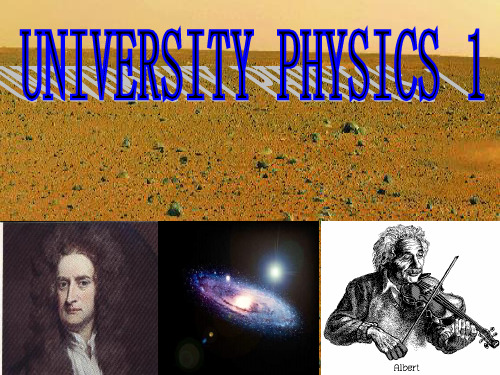
Magnitude: r r x 2 y 2 z 2
cos z r
In the two dimension: r r ( t ) x ( t )i y ( t ) j Its two components (分量) x x(t )
三天后 阿姆斯特朗 奥尔德林 柯林斯
Mars(火星)
机遇号
The surface of Mars(火星表面)
Our world and Universe
Universe
Elementary particles
In the view of physics history:
The ancient physics The classical physics The modern physics
Coordinate system ( 坐 标 It is convenient to 系 )thefixed onsurfaceframe, take : earth’s the relative to frame position, which of as our velocity, in most cases and reference acceleration orbit of course.( What in this the object can be specified quantitatively. cases?) Cartesian Coordinate system(直角坐标系): o
里德雷时间空间和万物23partonemechanicspartonemechanics24chapterkinematics第一章第一章质点运动学质点运动学kinematicskinematics11参考系质点framereferenceparticle12位置矢量位移positionvectordisplacement13速度加速度velocityacceleration14两类运动学问题twotypesproblems16运动描述的相对性relativemotion15圆周运动及其描述circularmotion理解描述质点运动物理量的定义及其矢量性相对性和瞬时性
物理专业英语-课件

物理专业英语English in Physics教材:《物理专业英语》,李淑侠、刘盛春,哈尔滨工业大学出版社学时:32目的:1、增加了解——专业词汇、语法、结构2、扩宽专业知识3、打基础——文献的查阅、翻译、写作内容:(5 parts)1、Mechanics力学2、Thermodynamics & Statistical Physics热力学与统计物理3、Optics光学4、Electromagnetism电磁学5、Modern Physics近代物理Part 1 The physical fundamentals of mechanicsCharpter1 kinematics§1-0 Prologuequestions:Can you briefly describe mechanics in your mind?Study the motion of the material bodiesHave long historyTremendous growth by Galileo and NewtonWhat can we do applying the principles of mechanics?Predict motions \ analyse motions and explain the causeWhy mechanics is most important branch of physics?The first complete branch,furnish the basic concepts of whole physics, influence theother branches.passages:✧Now we apply some principles to the motions of artificial satellites such as anorbiting Space Shuttle. In general, the principles of mechanics can be applied toi. The motions of celestial objects so as to accurately predict events, in somecases many years before they happen, for example, the return of the Halley’scomet;ii. The motions of ordinary objects on Earth , for example, an automobile or a thrown baseball;iii. The behavior of atoms, atomic particles, and subatomic particles, withconsiderable success.words:●kinematics[,kini'mætiks, kai]n. the branch of mechanics concerned with motion withoutreference to force or mass运动学;动力学●celestial [si'lestjəl] adj. adj.1. of or relating to the sky 2. relating to or inhabiting a divine heaven 3.of heaven or the spirit 天上的,天空的●space shuttle n. a reusable spacecraft with wings for a controlled descent through the Earth'satmosphere太空飞船●comet ['kɔmit] n. (astronomy) a relatively small extraterrestrial body consisting of a frozen massthat travels around the sun in a highly elliptical orbit●differentiate [,difə'renʃieit] v. 1. mark as different 2. be a distinctive feature, attribute, or trait;sometimes in a very positive sense 3. calculate a derivative; take the derivative4. becomedifferent during development cells differentiate 5. evolve so as to lead to a new species or develop in a way most suited to the environment 6. become distinct and acquire a different charactervi. 区分,区别vt. 区分,区别§1-1Mechanical motionquestions:●What must we introduce or consider when we describe the mechanical motion?●Why do we usually study the idea models, such as particle and rigid body?●When a body we study is regarded as a point particle ? or a rigid body?●How can we describe the motion of a body or system ?●How many kinds of the motion of the rigid body? And what they are?●Can you describe the Cartesian coordinates as a example in this section?Passage:✧It was indicated above that motion in mechanics is defined as the change in themutual arrangement of the bodies. If we imagine a separate isolated body in aspace where no others are present, then we cannot speak of the motion of thebody because there is nothing with respect to which the body could change its position. It thus follows that if we intend to study the motion of a body, then we must indicate with respect to what other bodies the given motion occurs.✧To describe the motion of a body means to indicate for every moment of thetime the position of the body in space and its velocity. To set the state of amechanical system, we must indicate the positions and the velocities of all thebodies forming the system. A typical problem of mechanics consists indetermining the states of a system at all the following moments of time t whenwe know the state of the system at a certain initial moment t0 and also the laws governing the motion.✧It is simpler to treat a point particle than an extended body. We shall thereforefirst study the mechanics of a particle, and then go over to the mechanics of arigid body. We shall start with kinematics, and then delve into dynamics. Weremind our reader that kinematics studies the motion of bodies without regardto what causes this motion. Dynamics studies the motion of bodies with a view to what causes this motion to have the nature it does, i.e. with a view to theinteractions between bodies.Word:timepiece ['taimpi:s] n. a measuring instrument or device for keeping time 计时器stationary ['steiʃənəri] adj. 1. standing still 2. not capable of being moved 固定的;静止的;定居的;常备军的reference frame n. a system that uses coordinates to establish position参考系,参考坐标系constant ['kɔnstənt]adj. 1. persistent in occurrence and unvarying in nature 2. continually recurring or continuing without interruption 3. steadfast in purpose or devotion or affection 4.uninterrupted in time and indefinitely long continuing n.1. a quantity that does not vary2. anumber representing a quantity adj. 不变的;恒定的;经常的n. [数] 常数;恒量corridor ['kɔridɔ:] n. an enclosed passageway; rooms usually open onto it走廊disengage [,disin'ɡeidʒ] v. release from something that holds fast, connects, or entangles 使脱离;解开;解除disengage from 使…从…脱离(或解脱、解除):deform [di'fɔ:m] v. 1. make formless 2. twist and press out of shape 3. cause (a plastic object) to assume a crooked or angular form 4. become misshapen 5. alter the shape of(something) by stress 6. assume a different shape or form vt. 使变形;使成畸形vi. 变形;变畸形adj. 畸形的;丑陋的Cartesian [kɑ:'tiziən] adj. of or relating to Rene Descartes or his works adj. 笛卡尔哲学的;笛卡尔的cartesian coordinate [数学]笛卡尔坐标cartesian coordinate system 笛卡儿坐标系统cartesian product 笛卡儿积cartesian space 直角坐标空间;欧几里得空间;笛卡儿空间rectangular ['rek'tæŋɡjulə] adj. 1. having four right angles 2. having a set of mutually perpendicular axes; meeting at right angles adj. 矩形的;成直角的lattice ['lætis] n. 1. an arrangement of points or particles or objects in a regular periodic pattern in 2 or 3 dimensions 2. small opening (like a window in a door) through which business can be transacted 3. framework consisting of an ornamental design made of strips of wood or metal[晶体] 晶格;格子;格架rod [rɔd] n. 1. a linear measure of 16.5 feet 2. a long thin implement made of metal or wood3. any rod-shaped bacterium4. a square rod of land5. visual receptor cell sensitive to dimlight 6. a gangster's pistol 棒;惩罚;枝条;权力identical [ai'dentikəl]adj. 同一的;完全相同的n. 完全相同的事物scale1 [skeil] n.1. an ordered reference standard 2. relative magnitude 3. the ratio between the size of something and a representation of it v.1. measure by or as if by a scale 2. pattern, make, regulate, set, measure, or estimate according to some rate or standard3. take by attacking withscaling ladders 4. reach the highest point of 5. measure with or as if with scales 6. size or measure according to a scale n.规模;比例;鳞;刻度;天平;数值范围v. 测量;依比例决定graduate ['ɡrædʒuət, 'ɡrædjueit] v 1. receive an academic degree upon completion of one's studies 2. make fine adjustments or divide into marked intervals for optimal measuringvt. 授予…学位;分等级;标上刻度synchronize ['siŋkrənaiz] v.1. make synchronous and adjust in time or manner 2. happen at the same time3. make (motion picture sound) exactly simultaneous with the action 4. arrange orrepresent events so that they co-occur 5. operate simultaneously 6. cause to indicate the same time or rate vt. 使……合拍;使……同步vi. 同步;同时发生go over 复习,重温;仔细检查;转变;润色delve [delv] v. turn up, loosen, or remove earthvi. 钻研;探究;挖i.e. 是拉丁文id est [id'est]的缩写,它的意思就是“那就是说,换句话说”,等同于“thatis,in other words” ,目的是用来进一步解释前面所说的观点。
物理专业英语
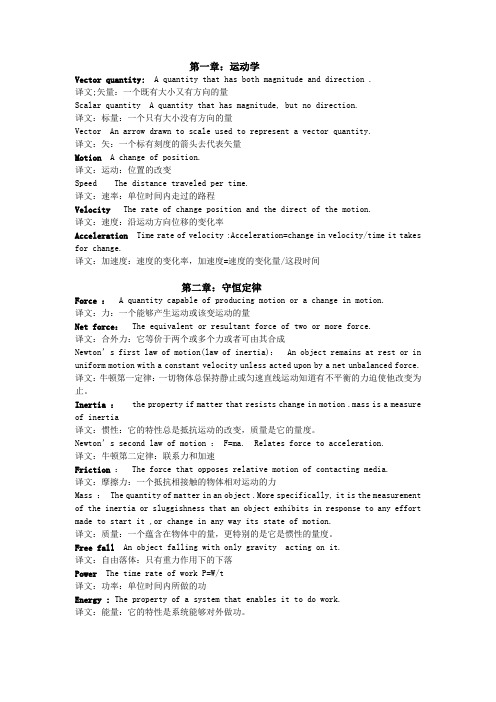
第一章:运动学Vector quantity: A quantity that has both magnitude and direction .译文;矢量:一个既有大小又有方向的量Scalar quantity A quantity that has magnitude, but no direction.译文:标量:一个只有大小没有方向的量Vector An arrow drawn to scale used to represent a vector quantity.译文:矢:一个标有刻度的箭头去代表矢量Motion A change of position.译文:运动:位置的改变Speed The distance traveled per time.译文:速率:单位时间内走过的路程Velocity The rate of change position and the direct of the motion.译文:速度:沿运动方向位移的变化率Acceleration Time rate of velocity :Acceleration=change in velocity/time it takes for change.译文:加速度:速度的变化率,加速度=速度的变化量/这段时间第二章:守恒定律Force : A quantity capable of producing motion or a change in motion.译文:力:一个能够产生运动或该变运动的量Net force: The equivalent or resultant force of two or more force.译文:合外力:它等价于两个或多个力或者可由其合成Newton’s first law of motion(law of inertia): An object remains at rest or in uniform motion with a constant velocity unless acted upon by a net unbalanced force.译文:牛顿第一定律:一切物体总保持静止或匀速直线运动知道有不平衡的力迫使他改变为止。
《物理学词典》

一 、几何光学 … … … … … … … … … 188 二 、光度学 … … … … … … … … … … … 206 三 、色度学 … … … … … … … … … … … 208 四 、干涉 … … … … … … … … … … … … 212 五 、衍射 … … … … … … … … … … … … 226 六 、偏振 … … … … … … … … … … … … 238 七 、散射和吸收 … … … … … … … … 247 八 、傅里叶光学 … … … … … … … … 249 九 、全息 … … … … … … … … … … … … 256 十 、非线性光学 … … … … … … … … 260 十一 、激光 … … … … … … … … … … … 264 十二 、统计光学 … … … … … … … … 269
本 书 适 合 本 科 及 本 科 以 上 学 历 读 者 使 用 ,是 广 大 物 理 学 工 作 者 和 相 关 学 科 专 业 人 员 、物 理 教 学 科 研 工 作 者 及 大 专 院 校 师 生 的 便 利 参 考 工 具 。
图书在版编目(CIP)数据
物理学词典/徐龙道等编著 .— 北京 :科学出版社 ,2004畅5 (科学版词典系列) ISBN 7唱03唱009564唱2
声学 … … … … … … … … … … … … … … 113
一 、振动与波 … … … … … … … … … 113 二 、物理声学 … … … … … … … … … 121 三 、非线性声学 … … … … … … … … 127 四 、量子声学 … … … … … … … … … 127 五 、电声学 … … … … … … … … … … … 128 六 、超声学 … … … … … … … … … … … 134 七 、光声学 … … … … … … … … … … … 139 八 、水声学 … … … … … … … … … … … 140 九 、建筑声学 … … … … … … … … … 146 十 、环境声学 … … … … … … … … … 149 十一 、生理声学 … … … … … … … … 152 十二 、语言声学 … … … … … … … … 153
物理专业英语名词解释
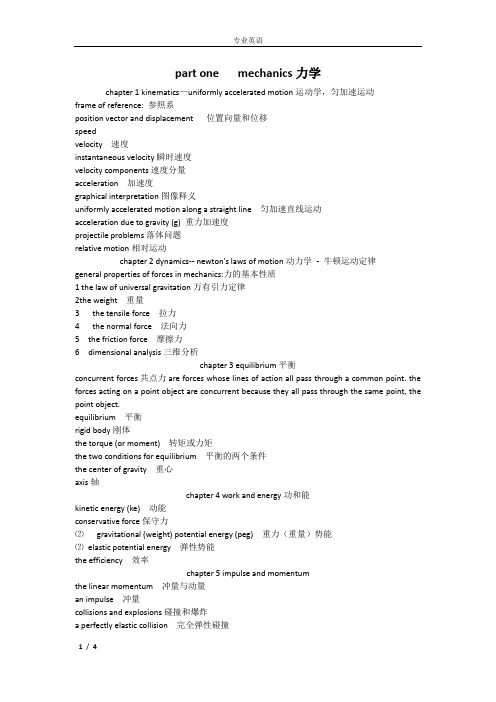
part one mechanics力学chapter 1 kinematics—uniformly accelerated motion运动学,匀加速运动frame of reference: 参照系position vector and displacement 位置向量和位移speedvelocity 速度instantaneous velocity瞬时速度velocity components速度分量acceleration 加速度graphical interpretation图像释义uniformly accelerated motion along a straight line 匀加速直线运动acceleration due to gravity (g) 重力加速度projectile problems落体问题relative motion相对运动chapter 2 dynamics-- newton's laws of motion动力学- 牛顿运动定律general properties of forces in mechanics:力的基本性质1 the law of universal gravitation万有引力定律2the weight 重量3 the tensile force 拉力4 the normal force 法向力5 the friction force 摩擦力6 dimensional analysis三维分析chapter 3 equilibrium平衡concurrent forces共点力are forces whose lines of action all pass through a common point. the forces acting on a point object are concurrent because they all pass through the same point, the point object.equilibrium 平衡rigid body刚体the torque (or moment) 转矩或力矩the two conditions for equilibrium 平衡的两个条件the center of gravity 重心axis轴chapter 4 work and energy功和能kinetic energy (ke) 动能conservative force保守力⑵gravitational (weight) potential energy (peg) 重力(重量)势能⑵elastic potential energy 弹性势能the efficiency 效率chapter 5 impulse and momentumthe linear momentum 冲量与动量an impulse 冲量collisions and explosions碰撞和爆炸a perfectly elastic collision 完全弹性碰撞coefficient of restitution恢复系数the center of mass重心chapter 6 rotation转动the angular speed 角速度the angular acceleration 角加速度tangential 【数】切线;正切centripetal acceleration ( )加速度the centripetal force 向心力chapter 7 rigid-body rotation刚体转动the moment of inertia 转动惯量parallel-axis theorem平行轴定理chapter 8 elasticity弹性elasticity弹性;弹力the stress 【物】应力[u][c]strain 应变the elastic limit弹性极限the shear modulus 切变模量standard atmospheric pressure标准大气压the hydrostatic pressure静水压力equation of continuity连续性方程the viscosity 粘度spring弹簧a restoring force 恢复力simple harmonic motion 简谐运动vibratory motion 振动运动the period ( ) 【数】循环节;周期the frequency ( ) 频率the elastic potential energy 弹性势能the simple pendulum 单摆chapter 11 wave motion波动a propagating wave 波传播wave terminology波术语in-phase vibrations同相振动standing waves驻波conditions for resonance共振的条件longitudinal (compressional) waves 纵向(挤压)波chapter 12 sound声音the intensey (i)强度loudness 响度beats节拍doppler effect 多普勒效应interference effects 干扰效应part two thermodynamics热力学chapter 1 the kinetic theory of gases第1章气体动力学理论avogadro's number ( ) 阿伏伽德罗数()the root mean square speed根均方速度the absolute temperature绝对温度the mean free path (m.f.p.) 平均自由程(m.f.p.)the equipartition theorem of energy 能量均分定理ideal gas law理想气体定律heat 热the internal energy 内部能量an isobaric process is a process carried out at constant pressure. 等压过程是恒压进行的过程。
物理学专业英语翻译

2.1 Introduction(引言)We begin our study of the physical universe by examining objects in motion. Thestudy of motion . whose measurement. more than 400 years ago gave birth to physics. iscalled kinematics.Much of our understanding of nature comes from observing the motion of objects. Inthis chapter we will develop a description for the motion of a single point as it movesthrough space. Although a point is a geometrical concept quite different from everydayobjects such as footballs and automobiles, we shall see that the actual mot10n of manyobjects is most easily described as the motion of a single point (the "center of mass"). plusthe rotation of the object about that point. Postponing a discussion of rotation. let usbegin he-re with a description of a single point as it moves through space. Space and timeKinematics is concerned with two basic questions. "Where?" and "When?". Thoughthe questions are simple. the answers are potentially quite complicated if we inquire aboutphenomena outside our ordinary daily experiences. For example. the physics of very highspeeds, or of events involving intergalactic distances or submicroscopic dimensions. isquite different from our common-sense ideas. We will discuss the… interesting subjects inlater chapters. For the present we shall adopt the space and time of Newton-thoseconcepts we gradually developed as a result of our everyday experiences.Space is assumed to be continuously uniform and isotropic. These two terms meanthat space has no 'graininess' and that whatever its properties may be, they areindependent of any particular direction or location. in the words of Isaac Newton.' Absolute space . in its own nature . without relation to anything external . remains alwayssimilar and unmovable. " Every object in the universe exists at a particular location inspace. and an object may change its location Ly moving through space as time goes on. Wespecify the Location of a particular point in space by its relation to a frame of reference.Time, according to Newton, is also absolute in the sense that it "flows on" at auniform rate . We cannot speed it up or slow it down in any way. in Newton's words," Absolute. true. and mathematical time . of itself . and from its own nature . flows equablywithout relation to anything external. and by another name is called duration. " Time isassumed to be continuous and ever advancing. as might be indicated by a clock.Space and time are wholly independent of each other. though it is recognized that allphysical objects must exist simultaneously in both space and time.Remarkably . many of these traditional ideas turn out to be naive and inconsistent withexperimental evidence. The world is just different from the picture we form from ourcommon-sense. intuitive ideas. Space and time, by themselves. arc concepts that arcdifficult (or perhaps impossible) to define in terms of anything simpler. However. we canmeasure space and time in unambiguous ways. We define certain operations by which weobtain numerical measurements of these quantities using rulers and clocks. based uponstandard units of space and time.For many years. our standard of time was based on astronomical observations of the earth'srotation. Because of the variations in the earth’s rotation . in 1967 the 13th General Conference onWeights and Measures. attended by 38 nations. adopted an atomic standard for time.Similarly. our former standard of length was the distance between two marks onplatinum-iridium bar. kept at Sevres. France. in 1960. the fundamental length standardwas redefined in terms of the wavelength of light emitted during a transition between two.The standard units of time and length may be described as follows:An interval of time. The fundamental unit is the second (s) . which by internationalagreement is defined as the duration of 9 192 631 770 periods of radiation corresponding tothe transition between the two lowest energy levels in the atomic isotope cesium 133.An interval of length. The fundamental unit is the meter (m). which is defined independently of the time interval Before 1983 . by international agreement the meter wasdefined as exactly 1 650 763. 73 wavelengths of the orange light emitted from the isotopekrypton 86. in November 1983. the length standard was defined as the distance that lighttravels in a vacuum in l1299 792 458 second.l angstrom(A) -. 10-l0 m l micron (u or um)10-6 m2.1简介(引言)我们开始研究宇宙的物理研究物体的运动。
专业英语物理

四、后置定语
� 大量使用后置定语也是科技文章的特点之一。常见的
结构不以下五种:
� 1、介词短语
The forces due to friction are called frictional forces. 由于摩擦而产生的力称之为摩擦力。 A call for paper is now being issued . 征集论文的通知现正陆续发出。
口语文体
� 这是小说中的一段对说,属于口语文体。其特点是:
用词自由,句法结构简单,短句与省略句多,自然朴 素,生活气息浓厚。
� 在译文中进一步体现汉语口语的特点,省去主语"你"、
"我";将英语的一个句子I don't think so.干脆译成一 个字"不",显得简洁有力。
文学文体
� She was of a helpless , fleshy build, with a frank , open helpless, frank,
� 那妇人生着一副绵软多肉(软弱丰满)的体格,一张坦
率开诚的面容,一种天真羞怯的神气。一双大落落的 柔顺眼睛,里边隐藏着无穷的心事,只有那些对于凄 惶无告的穷苦人面目作过同情观察的人才看得出来。
� 五十一个词的片断,就运用了十个形容词,占五分之一。
"and in then dwelt such a shadow of distress"是非常 优美生动的文学语言,译文保持了一风格。
there being no cause to change that motion.(状语从 句) 如果没有改变物体运动的原因,那么物体将作匀速 直线运动。 vibration producing one sound wave (并列分句). 振动着的物体产生声波,每一次振动产生一个声波。
物理专业英语翻译

第一章Our material world(物质世界) is composed of many substances distinguished(区别) by their chemical, mechanical, and electrical properties(特性). They are found in nature in various physical states(物理状态)---the familiar solid, liquid, and gas, along with(连同) the ionic "plasma "(等离子体) However, the apparent diversity(多样性) of kinds and forms of material is reduced by the knowledge that there are only a little over 100 distinct chemical elements(元素) and that the chemical and physical features of substances depend merely on the strength of force bonds(结合) between atoms. 我们的物质世界(物质世界)是由许多物质(以区别区别被其化工、机械、、电气性能(特性)。
他们是在大自然中找到的材料在不同的物理状态(物理状态)——而且熟悉的固体、液体和气体,随着(连同)离子“等离子体”(等离子体)然而,明显的多样性(多样性)各类形式的资料将减少知识只有一个小超过100种特定的化学元素(元素),化学和物理特征的物质的力量仅仅看力债券(结合)之间的原子。
In turn(依次), the distinctions between the elements of nature arise from(起于) the number and arrangement of basic particles(基本粒子)—electrons(电子), protons(质子), and neutrons(中子). At both the atomic and nuclear levels, the structure of elements is determined by internal forces and energy(内力和内能).1.1 FORCES AND ENERGY(力和能量)反过来(依次),区别自然元素(源自起于)电话号码和安排基本粒子)-electrons基本粒子(电子),质子((质子),和中子(中子)。
- 1、下载文档前请自行甄别文档内容的完整性,平台不提供额外的编辑、内容补充、找答案等附加服务。
- 2、"仅部分预览"的文档,不可在线预览部分如存在完整性等问题,可反馈申请退款(可完整预览的文档不适用该条件!)。
- 3、如文档侵犯您的权益,请联系客服反馈,我们会尽快为您处理(人工客服工作时间:9:00-18:30)。
5.1 丨INFORMA TION FROM THE THEORY OF PROBABILITY Assume that we have a macroscopic system, i.e. a system formed by an enormous number of microparticles ( molecules, atoms, ions, electrons) ,in a given state. Assume further that a quantity x characteristic of the system can have the discrete valuess k i x x x x x x ,...,...,,...,,,,321Let us make a very great number N of measurements of the quantity x ,bringing the system before each measurement to the same initial state ? Instead of performing repeated measurements of the same system, we can take N identical systems in the same state and measure the quantity N once in all these systems. Such a set of identical systems in an identical state is called a statistical ensemble.Assume that N\ measurements gave the result X\, measurementsthe result x2,…,Ni measurements the result X\,and so on ( X) = TV is the number of systems in the ensemble) ? The quantity N^/N is defined as the relative frequency of appearance of the result xt while the limit of this quantity obtained when N tends to infinity, i.e.N N p iN i →∝=lim (5.1) is called the probability of appearance of the result Xi. In the following , in order to simplify the equations, we shall write the expression for the probability in the form Ni/N ,bearing in mind that the transition to thelimit is performed at N →∝. Since ∑Ni/N, we have1=∑=∑N N P ii (5.2)i.e. the sum of the probabilities of all possible results of measurement e- quals unity.The probability of obtaining the result Xi or iski kki iork P P N N N NiN N N P +=+=+=We have thus arrived at the theorem of summation of probabilities. It states thatk i iork P P P += (5.3)Assume that a system is characterized by the values of two quantities x and y ? Both quantities can take on discrete values whose probabilities of appearance areN N P N N P i k i i x y x x )()()()(,==Let us find the probability )(,k i y x P of the fact that a certainmeasurement will give the result for x and yk for y . The result is obtained in a number of measurements equal to N x P x N i i )()(=. If the value of the quantity y does not depend on that of x, then the result k y will be obtained simultaneously with Xi in a number of cases equal to)(])([)()(),(k i k i k i y P N x P y P x N y x N ==[)(i x N plays the part of N for y]. Tlie required probability is)()(),(),(k i k i k i y P x P N y x N y x P ==Now we have arrived at the theorem of multiplication of probabilities according to which the probability of the simultaneous occurrence of statistically independent events equals the product of the probabilities of each of them occuning separately:)()(),(k i k i y P x P y x P = (5.4) Knowing the probability of the appearance of different measurement results, we can find the mean value of all the results. According to the definition of the mean valueixiixiP N N x ∑=∑>=< (5.5)Let us extend the results obtained to the case when the quantity x characterizing a system can take on a continuous series of values from zero to infinity. In this case, the quantity x is said to have a continuous spectrum of values (in the previous case the spectrum of values was discrete) .Let us take a very small quantity a (say, a = 10~6) and find the number of measurements 0N ∆which give a x <<0, the number 1N ∆ which give a< x <2a ,…, the number x N ∆ for which the result of the measurements is within the interval from x to x + a, and so on. The probability of the fact that the result of the measurements will be within the interval from zero to a is N N P /00∆=∆,within the interval from a to 2a is N N P /11∆=∆,…, within the interval from x to x + a is N N P x x /∆=∆. Let us draw an x-axis and lay off strips of width a and of heighta P x /∆ upward from it (Fig. 5. la). We obtain a bar graph or histogram. The area of the bar whose left-hand edge has the coordinate x is APX, and the area of the entire histogram is unity [see Eq. (5.2)].A histogram characterizes graphically the probability of obtaining results of measurements confined within different intervals of width a. The smaller the width of the interval a ,the more detailed will the distribution of the probabilities of obtaining definite values of ^ be characterized. In the limit when a —0, the stepped line confining the histogram transforms into a smooth curve (Fig. 5. lb).The function f(x) defining this curve analytically is called a probability distribution function.In accordance with the procedure followed in plotting the distribution curve, the area of the bar of width dx (see Fig. 5.1b) equals the probability of the fact that the result of a measurement will be within the range from x to x + dx.Denoting this probability by dPx, we can writethatdx x f dP x)(=(5.6) TTie subscript “x” used with dp indicates that we have in mind the probability for the interval whose left-hand edge is at the point with the coordinate x ? The area confined by a distribution curve ,like that of a histogram, equals unity. This signifies that1)(==⎰⎰x dP dx x f (5.7)Integration is performed over the entire interval of possible values of the quantity x. Equation (5.7) is an analogue of Eq. (5.2).Knowing the distribution function f(x) 9 we can find the mean value of the result of measuring the quantity x. In ANX = NdPx cases, a result equal to x is obtained. The sum of such results is determined by the expression xdNx = xNdPx. The sum of all the possible results isj xdNx = JxNdPx . Dividing this sum by the number of measurements TV , we get the mean value of the quantity x :x xdP x ⎰>=<(5.8) This equation is an analogue of Eq. (5.5).Using Eq. (5.6) for dPx in Eq. (5.8), we obtaindx x f x x )(⎰>=<(5.9) Similar reasoning shows that the the mean value of a function <p(x) can be calculated by the equationdx x f x x )(⎰>=<(5.10) For examqle,⎰>=<dx x f x x)(22 (5.11)5.2 NA TURE OF THE THERMAL MOTION OF MOLECULESIf a gas is in equilibrium, its molecules move absolutely without order, chaotically. All the directions of motion are equally probable, and none of them can be given preference over others. The velocities of the molecules may have the most diverse values. Upon each collision with other molecules, the magnitude of the velocity or speed of a given molecule should, generally speaking, change. It may grow or diminish with equal probability.The velocities of molecules change by chance upon collisions. A molecule in a series of consecutive collisions may receive energy from its collision partners, and as a result its energy will considerably exceed the mean value 〈 e 〉? Even if we imagine the absolutely fantastic case, however, in which all the molecules of a gas give up their energy to a single molecule and stop moving, the energy of this molecule, and consequently its velocity too, will still be finite. Thus, the velocity of molecules of a gas cannot have values beginning with a certain vmax and ending with infinity. Taking into consideration that processes which would lead to the concentration of a considerable portion of the total energy of all the molecules on one molecule have a low probability, we can say that very high velocities in comparison with the mean value of the velocity can be realized extremely rarely. In exactly the same way, it is virtually impossible for the velocity of a molecule to vanish completely as a result of collisions. Hence, very low and very high velocities in comparison with the mean value have a low probability ? The probability of the given value of v tends to zero both when v tends to zero and when it tends to infinity. It thus follows that the velocities of molecules are mainly grouped near a certain most probable value.The chaotic nature of motion of molecules can be illustrated with the aid of the following procedure. Let us surround point 0 with a sphere of arbitrary radius r (Fig. 5.2). Any point A on this sphere determines the direction from 0 to A. Consequently ,the direction in which the molecules of a gas move at a certain moment can be set by points Fig.5.2on the sphere. The equal probability of all the directions results in the fact that the points showing the directions of motion of the molecules will bedistributed over the sphere with a constant density. The latter equals the number N of molecules being considered divided by the surface area of the sphere 4tct . Collisions lead to changes in the directions of motion of the molecules. As a result, the positions of the N points on the sphere continuously change. Owing to the chaotic nature of the motion of the molecules, however, the density of the points at any spot on the sphereremains constant all the time.Tlie number of possible directions in space is infinitely great ? But at each moment a finite number of directions is realized, equal to the number of molecules being considered. TTierefore, putting the question of the number of molecules having a given ( depicted by the point on the sphere) direction of motion is deprived of all meaning. Indeed, since the number of possible directions is infinitely great, whereas the number of molecules is finite, the probability of at least one molecule flying in a strictly definite direction equals zero. A question we are able to answer is what number of molecules move in directions close to the given one (determined by point A on the sphere) ? All the points of the surface elements AS of the sphere taken in the vicinity of point A (see Fig.5.2) correspond to these directions. Since the points depicting the directions of motion of the molecules are distributed uniformly over the sphere, then the number of points within the area AS will be24r SN N A π∆=∆ (5-12)Tlie subscript A indicates that we have in view the molecules whose directions of motion are close to that determined by point A.The ratio AS/r2 is the solid angle subtended by the area AS ? Tlierefore, Eq. (5.12) can be written as follows:π4∆Ω=∆N N A (5.13)Here is the solid angle containing the directions of motion of the molecules being considered. We remind our reader that 4zr is a complete solid angle (corresponding to the entire surface of the sphere) ?The direction of OA can be given with the aid of the polar angle Q and the azimuth cp (Fig. 5.3). Hence, the directions of motion of the molecules of a gas can be characterized by giving for each molecule the values of the angles 6 and cp measured from a fixed direction OZ (we can take the direction of a normal to the surface of the vessel confining a gas as such a direction) and the plane P0, drawn through it.Let us surround the origin of coordinates 0 with a sphere of radius r and find the element dS of the sphere corresponding to the increments Ad and Acp of the angles 9 and cp (Fig.5.4) . The element being considered is a rectangle with the sides rdS and r ϕθθd d sin .Thusϕθθd d rdS sin 2=(5.14) Tlie expression obtained gives an element of the surface r = const in a spherical system of coordinates.Dividing Eq. (5.14) by r2 we shall find the element of the solid angle corresponding to the angle intervals from d to 6 + dd and from cp to (p + dcp.ϕθθϕθd d d sin ,=Ω (5.15) Two spheres of radius r and r + dr, two cones with the apex angles 6 and d + dd 9 and two planes forming the angles ϕ and d ϕ with P0 separate in space a rectangular parallelepiped with the sides rsin θ and dr (see Fig. 5.4) . The volume of this parallelepipedϕθθd drd r dV sin 2= (5.16) is an element of volume in a spherical system of coordinates (the volumecorresponding to an increase in the coordinates r ,6 and cp by dr, dd , and d^) ?Passing over from deltas to differentials in Eq. (5. 13) and introducing Eq. (5.15) for d Ω,we arrive at the expressionπϕθθπϕθϕθ4sin 4,,d d N D N dN =Ω= (5.17)The subscripts 6 and cp of dTV indicate that we have in view the molecules whose directions of motion correspond to the angle intervals from θto θ+ d θand from ϕto ϕ+ d ϕ.。
